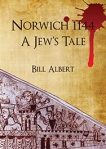 The Talkative Corpse by Ann Sterzinger
The Talkative Corpse by Ann Sterzinger
Review by Frank Marcopolos
Lurking in the shadows of the seedy underbelly of the American heartland are the kinds of people you’re probably scared of. The kinds of people you, perhaps, don’t think of often. The kinds of people who just scrape by, praying for lottery-ticket miracles, and Heavenly rewards, and three consecutive days of tranquility and security. People like John Jaggo.
John Jaggo, of course, is long dead. He did, however, come up with an ingenious way to preserve his thoughts about his rough daily life circa 2011-2012—an electronic diary, unearthed by future geologists-cum-psychologists, which becomes the narrative of The Talkative Corpse (CreateSpace, 192 pages) an intriguing novel by Ann Sterzinger.
Continue to Dactyl Review
 Norwich 1144 – A Jew’s Tale by Bill Albert
Norwich 1144 – A Jew’s Tale by Bill Albert
Review by Charles Davis
In the preface to his latest novel, Norwich 1144 – A Jew’s Tale (Mousehold Press, 256 pages), Bill Albert recalls the encounter that inspired his story:
“I was in a sixteenth century synagogue in Safed, a town 1000 metres above the Sea of Galilee. The rabbi, who looked as if he had been with the building since it was built, asked me where I lived. I told him I lived in Norwich, England. He looked alarmed, and then without missing a beat he turned and spat dryly over his shoulder three times. Having thereby ensured that the Evil Eye was placated, he told me the story of William of Norwich.
“In March, 1144, the body of William, a 13-year old boy, was discovered in Thorpe Wood, near Norwich. His death was blamed on the small community of Jews in the city who were alleged to have killed him as part of a religious ceremony. Mob violence erupted against the Jews. About five years later, Thomas of Monmouth, a monk in the Cathedral Priory, wrote a book that helped to transform William into a local saint. This was the first documented accusation of the ritual murder in Europe of a Christian child by Jews – what was to become known, in somewhat different circumstances, as the Blood Libel.
Continue to Dactyl Review

Dismantle The Sun by Jim Snowden
Review by PaulXylinides
“Someone had to die for Hal Nickerson to live in the house that he and his wife Jodie bought for a song seven years ago.” So begins this dry-toned, cool, and detached novel Dismantle The Sun (Booktrope Editions, 324 pages) with a line and a sentiment that prove to be something of a mantra for its main protagonist and a lynchpin refrain for the narrative arc. In the world of nature — in the world of man — something has to die for something else to live. Some persons — the Nickersons — include this in their ample proof of the non-existence of a beneficent Creator, while others — the fundamentalists — attribute the state of the cosmos to original and ongoing sin. Both take it all very personally. Hal Nickerson’s atheism in conjunction with that of his wife informs all of his sensibility while providing a certain distance from the most basic issues of life and death, love and hatred.
As rational nonbelievers they try to live as much in accord with the laws of nature as they perceive them. Their aforementioned house had been designed in the clean spare fashion of the architects Mies van der Rohe and Frank Lloyd Wright:
“The cold inhumanity of Bauhaus fit well with Lloyd Wright’s desire to build in harmony with nature because Upper Michigan was a frozen despairing waste six months out the year.”
Continue to Dactyl Review.
